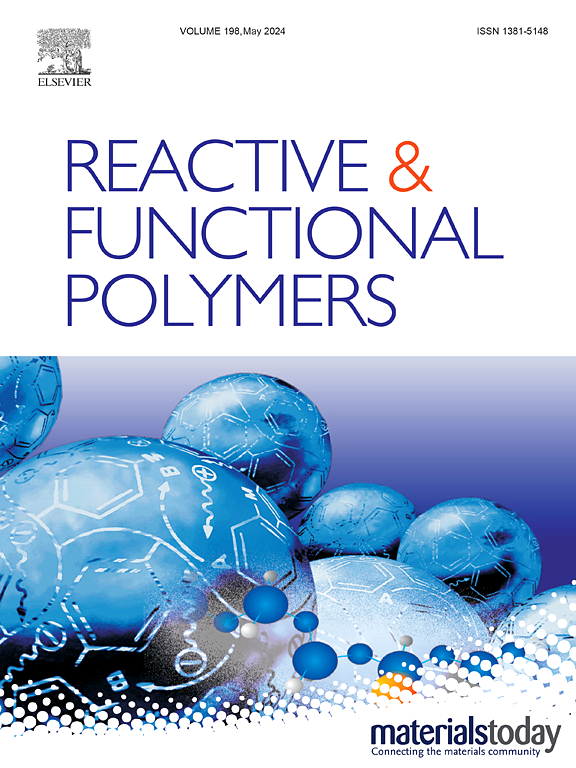同时超交联和功能化多孔聚苯乙烯吸附剂去除蛋白质结合的尿毒症毒素
IF 4.5
3区 工程技术
Q1 CHEMISTRY, APPLIED
引用次数: 0
摘要
蛋白结合尿毒症毒素(PBUTs)在尿毒症并发症的进展中起着至关重要的作用。由于PBUTs与人血清白蛋白的结合亲和力极高,传统的血液透析方法很难去除PBUTs。血液灌流作为一种先进的血液净化技术,已被证明对PBUTs的去除效果显著,超交联聚苯乙烯吸附剂作为血液灌流吸附材料已被广泛商业化。然而,挑战仍然存在,包括需要提高PBUTs的吸附效率,以及简化吸附剂的制备和改性工艺。本文以叔胺类官能团的N,N-二甲基甲酰胺二甲基缩醛(DFDA)为小分子外交联剂,同时进行了Friedel-Crafts烷基化交联和官能团接枝改性,采用一步外交联改性技术制备了功能化超交联聚苯乙烯吸附剂HCP-DFDA。实验结果表明,制备的高交联树脂HCP-DFDA具有丰富的介孔/微孔结构,具有极高的比表面积,可达1030 m2/g。吸附实验表明,HCP-DFDA对硫酸吲哚酚(IS)和对甲酰硫酸酯(PCS)等尿毒症PBUTs以及β2-微球蛋白(β2-MG)和白细胞介素-6 (IL-6)等中、大分子毒素均具有良好的吸附性能。此外,与商用HA130树脂相似,HCP-DFDA具有较低的蛋白质吸附率和溶血率,具有良好的血液相容性。综上所述,本研究提出的改性高交联吸附剂制备方法简便易行,为临床应用全血灌流高效去除PBUTs提供了新的思路和解决方案。本文章由计算机程序翻译,如有差异,请以英文原文为准。

Simultaneous hypercrosslinking and functionalization of porous polystyrene adsorbent for protein-bound uraemic toxins removal
Protein-bound uremic toxins (PBUTs) play a crucial role in the progression of uremic complications. Due to the extremely high binding affinity to human serum albumin, PBUTs are poorly removed by traditional hemodialysis methods. As an advanced blood purification technology, hemoperfusion has been proven effective in removing PBUTs, and hyper-crosslinked polystyrene adsorbents have been widely commercialized as hemoperfusion adsorption materials. However, challenges still remain, including the need to enhance the adsorption efficiency of PBUTs and the simplification of the preparation and modification processes of the adsorbents. In this work, we report a one-step external crosslinking modification technique to prepare a functionalized hyper-crosslinked polystyrene adsorbent named HCP-DFDA, in which N,N-dimethylformamide dimethyl acetal (DFDA) with tertiary amine functional groups was used as a small-molecule external crosslinker to simultaneously carry out Friedel–Crafts alkylation crosslinking and functional group grafting modification. Experimental results showed that the prepared hypercrosslinked resin HCP-DFDA had abundant mesoporous/microporous structures and an extremely high specific surface area of up to 1030 m2/g. Adsorption experiments demonstrated that HCP-DFDA exhibited excellent adsorption performance for both uremic PBUTs like indoxyl sulfate (IS) and p-cresyl sulfate (PCS) and medium- to large-molecular-weight toxins such as β2-microglobulin (β2-MG) and interleukin-6 (IL-6). Moreover, similar to the commercial HA130 resin, HCP-DFDA exhibited low protein adsorption and hemolysis rates, demonstrating good blood compatibility. In summary, the facile preparation method of the modified hypercrosslinked adsorbent proposed in this study provides a new idea and solution for the efficient removal of PBUTs through whole-blood hemoperfusion in clinical applications.
求助全文
通过发布文献求助,成功后即可免费获取论文全文。
去求助
来源期刊

Reactive & Functional Polymers
工程技术-高分子科学
CiteScore
8.90
自引率
5.90%
发文量
259
审稿时长
27 days
期刊介绍:
Reactive & Functional Polymers provides a forum to disseminate original ideas, concepts and developments in the science and technology of polymers with functional groups, which impart specific chemical reactivity or physical, chemical, structural, biological, and pharmacological functionality. The scope covers organic polymers, acting for instance as reagents, catalysts, templates, ion-exchangers, selective sorbents, chelating or antimicrobial agents, drug carriers, sensors, membranes, and hydrogels. This also includes reactive cross-linkable prepolymers and high-performance thermosetting polymers, natural or degradable polymers, conducting polymers, and porous polymers.
Original research articles must contain thorough molecular and material characterization data on synthesis of the above polymers in combination with their applications. Applications include but are not limited to catalysis, water or effluent treatment, separations and recovery, electronics and information storage, energy conversion, encapsulation, or adhesion.
 求助内容:
求助内容: 应助结果提醒方式:
应助结果提醒方式:


